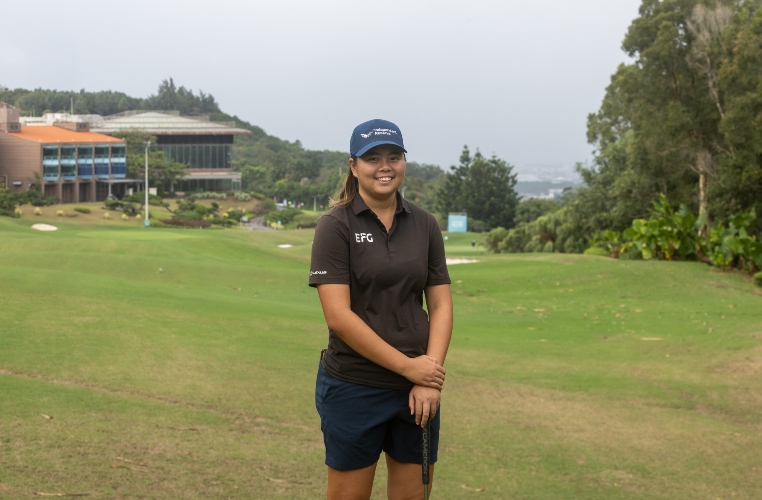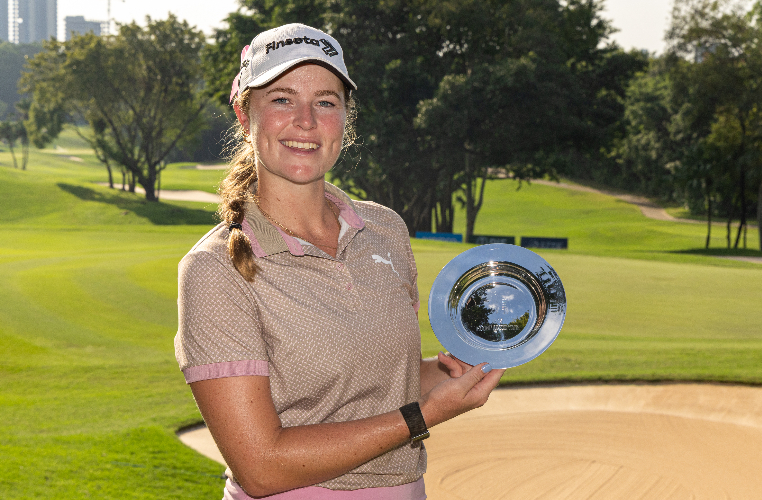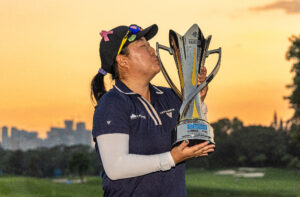U.S. Captain Patty Sheehan (PS) European Captain Catrin Nilsmark (CN)
Thank you both for joining us. This is our first media opportunity with the captains of this year’s Solheim Cup teams. Just wanted to open it up for both of you some opening remarks. We’ll start with you, Patty. Maybe you could reflect a little bit back on last year and then talk about what you’re looking forward to for this year and, Catrin, maybe you could talk about the transition from being a player on the team to now being a captain this year.
PS: First of all, I would like to welcome Catrin up on the podium as a captain of the European team. To me, it was quite an honor sitting up here a couple years ago. It was really a lot of fun to see Dale and to converse with her a little bit, and we have done a little bit of that in the last couple of days. I’ve talked with Catrin about a few things and we have enjoyed chatting about those few things that we’ve chatted about, which we probably won’t be talking to you about.
I am extremely proud and honored to be the winning captain of the last Solheim Cup. It was a great experience, one of the most gratifying experiences, I think, of my career. It was obviously a lot different being the captain and not a player. The responsibilities are so much more, and it was a great experience and I’ll never forget it and I’ll cherish it forever. My players made me look good and I appreciated that, I thanked them all for that, and we had a good time. It was a great venue. Interlachen was wonderful, the people were tremendous. The help that they gave all of us, both teams, was just incredible.
I’m looking forward to — what is it, about six months from now — being in Sweden. Catrin is going to be a great hostess, and we all look forward to being at the Solheim Cup, even though it will have only been one year. It’s going to be kind of strange. But I look forward to watching my team progress through the year, watching the points, watching them juggle for position and kiss up to their captains a little bit, which is always the fun part of it. You’ve got the players right where you want them, Catrin, trust me. It’s just a lot of fun to be a part of that and watch the progress.
It’s going to be an exciting event again. Catrin probably knows a lot more about what’s going to be happening over there since I’ve never been to Sweden, but I have heard that they are looking forward to tremendous crowds and that’s always a lot of fun to play in front of enormous crowds, and I know the Swedish people are looking very much forward to it. I’ll let Catrin talk about that. Thank you.
CN: Well, I’m not as good as Patty with keeping my mouth shut, so I’m happy to tell you what we talked about in the locker room, but we’ll do that later when she’s gone. No, I’m very honored and pleased to be here, obviously. I’ve been looking forward to this year and this season to start, and you asked me a little bit about going from being a player to a captain. I almost don’t know yet, but I personally have my goals with my golf, as I’ve had before, and I’m going to play a full schedule as I have the last few years, the 16 I’ve been on Tour.
But obviously I’ll be keeping my eyes much more on the players than I have in the past, which I think is just really a positive for thing for me, not being quite so wrapped up entirely in your own game. Already really enjoying talking to the other players about their games, about their plans and talking to Patty and getting to know her even more than I have. You mentioned Barsebäck. I think we’re going to have — I know we’re going to have a wonderful event. All the plans are looking great, and I’m sure it will — the tickets will be sold out. It will be a fantastic crowd.
Q: Can you talk about how special it will be to be captain in your home country of Sweden?
CN: Yeah, it is special, I think, because although many people travel to The Solheim Cup from around the world, it will be mainly Swedish people there, and so I’m sure it will be a little special, although I have to say every Solheim Cup I’ve played has been extremely special. So it’s hard to beat those feelings. So we’ll see. Maybe it’s possible. I hope so.
Q: For those of us who are unfamiliar with this course you’re going to be playing on, could you tell us a little bit about it, the style of course?
CN: It’s one of the best courses we have in Sweden, if not the highest ranked. It’s a seaside course. A few of the holes are actually right by the sea, maybe some 60 yards or so, and it’s a fairly flat course. The finishing four or five holes — well, they really didn’t — the last five holes are somewhat between pine trees. Not so tight except for maybe one or two holes at the very end, little pine-lined tight fairways, but it’s a beautiful golf course. I would say it’s a very fair golf course. You don’t have any pot bunkers. You don’t have any big undulations on the greens. What you see is what you get, and I think the main issue is going to be the weather. It can be really windy there. If it does blow, that will be the interesting part, I think.
Q: Is that the Atlantic Ocean?
CN: The North Sea? Yeah, the North Sea.
Q: Are there going to be any nuances to the competition? I know in the Ryder Cup, the captains made some changes last year eliminating the practice putting and that sort of thing. Have you talked about anything along those lines that would make procedures any different than usual?
PS: I don’t know if they talked about that yesterday or not.
CN: No.
PS: A lot of times we’re in the dark with some of the decisions that are made, but, you know, we’ll get that all hammered out — we’ll get that hammered out. We haven’t gotten quite into those types of things yet, but I’m sure we will be. Catrin, did you hear anything about that?
PS: Probably won’t have too many changes.
Q: Catrin, this is your home field. Let’s probe a little bit. You’ve played this golf course yourself?
CN: Yes, we’ve had the Swedish Compaq Open there a few times. I’ve played a few company days there. Although this time we’re playing — I’ve played a little different golf course. They’re now making us play the same route as the Scandinavian Masters, the men’s PGA event is being played, and I think this is going to be — it’s only improved the way the golf course is set up. There were a few iffy holes before. So now it’s a true — really truly a championship course.
They also are redoing a par 3 that was a little — went uphill and you couldn’t really see the green. You could see the top of the flag. So that’s eliminated. So I have nothing but positive things, really, to say about the golf course.
Q: Tell us about your scores on that golf course.
CN: That is a good question. I don’t have a very good memory. But I did have a good finish when we did play there last time. I think I finished third or fourth. Annika, surprisingly, won. The course really suits her game. She didn’t at that time hit the ball very hard. So she, I think, breezed around and won by some 10 shots or so. And we all struggled up there in the wind trying to hit everything low. So I have played some good golf there.
Q: You’re not doing a home job on the team now, Annika wins there, Annika plays it well?
CN: I think it’s no surprise. Patty — I said in the old days, she was hitting the ball low. Now I haven’t played with her for a while.
Q: What type of player do you think it favors? A low ball hitter, obviously. CN: If the wind gets up, yeah, a low-ball hitter is probably to be favored, and possibly a long hitter.
Q: Catrin, you mentioned wind, but we’ve played a lot of Solheim Cup matches in some moisture also. Is that part of what you find there that time of year, too?
CN: Actually, you never really know, but I say this, last year the same week we’re playing this year, we had 78, 80 degrees, sunshine, calm days every day for a whole week. So, you know it’s not going to happen again. I hope you’re making up some really nice warm clothes, Patty, for your team.
PS: I think we’re going to have to have a combination of warm clothes and cool clothes. Bring an awful lot of clothes. Changeable weather.
Q: What kind of greens do they have there?
CN: They have just relaid the greens and they are supposed to be fantastic. I have not putted them yet, so I wouldn’t know, but special new fantastic grass from Austria. So, we’ll have to see when we get there. Should be fairly fast, although they always have to keep the pace, you know, not too fast, obviously for the windy conditions.
Q: The best way to get there, fly to Copenhagen and drive across the river?
CN: That is the best way. It’s about a 40-minute drive from Copenhagen Airport.
PS: We all want you to come, too, by the way. We would love to see your faces there.
Q: Patty, could you talk a little bit about what you learned from being captain last year as far as managing a team and how that will help you this year?
PS: Well, you know, I’m kind of a slow learner, so whatever it was that was successful, I’m not really sure what it was. All I know is that my players played their hearts out, and I was there behind them with big pom-poms.
CN: You don’t want to say that because I’m sitting here, right?
PS: It was just an interesting experience trying to put together the different personalities and their game types. I probably did more studying last year than I did in college. It meant that much to me that I put so much time into it. So I learned that it meant a lot more to me, I think, than initially I thought it would. So, it was just a wonderful experience. I know Catrin will enjoy it as much as I did.
Q: At Interlachen you were playing one of the great old courses that was built-in tough and you knew it going in, didn’t you?
PS: Yeah, I had been there a couple times and played it myself, and as it’s an old Donald Ross course, but fortunately we as players on the Tour, European players as well, have opportunities to play Donald Ross courses. So they were all sort of clued into what type of golf course they were going to play. I think most of us are sort of in the dark about Barsebäck right now. We don’t know very much about it, and we’re hoping to get over there for at least one day before we venture onto The Solheim Cup.
Q: You do plan to take the team over?
PS: I hope so, yeah.
Q: And practice for what, two, three rounds?
PS: Probably one. I think that’s about all we’re going to have time for.
Q: That will be tied into your trip in the Women’s British?
PS: Probably. Yeah. About that time.
Q: Catrin, are you going to consult with Dale to get a few pointers about how to pull this off?
CN: Probably. I met her in Australia in January, and we did talk quite a bit. She’s happy to give me lots of information. But at the same time, I think it’s good also to — you need to listen, you know, to what she has to say, what was good, what was bad, but also I think it’s important to try and make your own way and talk to the players your way and sort of make some plans from my point of view.
Q: Patty, I just happened to be from Interlachen, so there you go, of course. What’s the role that Jacques Olsen, the Interlachen pro, will have with you this year? I heard he was going over and doing something to help.
PS: Yeah, he has volunteered to come over and help me, so I’m not sure what his role will be. He might be the guy carrying the towels. I’m not sure. We’re going to put him in a really strategic spot, I’m sure, that will be extremely helpful. He’s a great guy, and he was a tremendous help to me last year, and he just loved The Solheim Cup so much he wanted to come again this year. So I think he and Sherry are coming and we certainly welcome them.
Q: Catrin, some of the European Solheim Cup Teams under British and Scottish captaincies have had as many as six Swedes on the team. Are the players getting nervous that maybe there will be 10 Swedes — I’m being a little facetious, but… are you taking any flak from them about that?
CN: No, not at all. I really don’t think the players are concerned about that. I hope not.
Q: Well, they may play their way onto the team, too.
CN: Exactly. No. My answer would have to be no. I have no friends from Sweden. Joking.
Q: This is the 100th anniversary of golf in Sweden or something like that. Is it a big deal or not?
CN: I’m not so sure — or I’m not sure of everything they have lined up for this year, but it is the 100th anniversary for the Swedish Golf Federation. So, I think they’ll try to make the most out of the fact that they do celebrate this with the biggest event ever in Swedish golf history, which will be The Solheim Cup. (*Editor’s note: The 2003 Solheim Cup is the kickoff for the 100th Anniversary of the Swedish Golf Federation, which will be celebrated in 2004.)
Q: Catrin, you have only one year now between The Solheim Cup teams. So, how do you go about picking the team now? Is it a point proposition for a certain number of players like it’s been in the past but it will only be one year?
CN: It’s actually two years, like it has been, and it started already last year when we did, in fact, play the last Solheim Cup.
Q: So you will consider points for two years?
CN: Yeah, and last year was half the points and this year it’s double. (*Editor’s note: LPGA players began accumulating points toward the 2003 U.S. Solheim Cup Team beginning with the 2002 LPGA Takefuji Classic. The European Solheim Cup Team members began receiving points at the beginning of the 2002 Evian Ladies European Tour season.)
Q: Okay. And you go by points to pick, what, five or six members? CN: I pick seven from the order of merit and then I have five wild cards.
Q: Patty, you’re a little bit the other way, you only get to pick two, right?
PS: I get to pick two and I’m glad I don’t have to pick five. Our point system is pretty much the same as it’s always been, it’s a tiny bit different, but we have also been accumulating points through last year, and it’s a point and a half this year, doubles for majors.
Q: Can you talk about if you picked your assistant captains for this year and who they will and be how you anticipate them helping you through the process?
CN: Well, yeah, I picked mine. It’s Alison Nicholas from England, and she is the organized one of the two of us. So I picked her to keep track of all papers and to do all the phone calls and keep in touch with people and I’ll just get to go around and watch everybody else’s golf, really.
PS: Good plan. I’ve got Jane Geddes again. She did a great job last year. She was extremely helpful. I just couldn’t imagine anybody else that I would rather have as my assistant this year. So, I asked her back like four or five times, I wasn’t sure if I was getting a straight answer from her, but finally I pinned her down and she said, yeah, she would love to do it. So we’re going to have some fun again.
Q: The two of you have only met once in Solheim Cup play face to face and you won, Patty?
PS: Yeah, barely.
Q: However, Catrin has a better overall match-play record in the Solheim Cup. Does that mean that the playing field is even?
PS: Well, I don’t know. You know — let me just interject about Catrin. I believe her first time was at Dalmahoy, and I honestly and sincerely was so happy for her because she won the winning point for the European team, and I was, you know — she didn’t get a lot of chances to play that week, and I was very happy that she was the one that was able to win the winning point for the European team and I have told her this, and I sincerely mean it, that that was a great thing for her and her career, to have that happen to her.
CN: Thank you, Patty. If you didn’t tell them that, you did come up and tell me this, a few years ago, just a couple three years ago, maybe, and that meant a lot to me, very, very nice remarks.



















